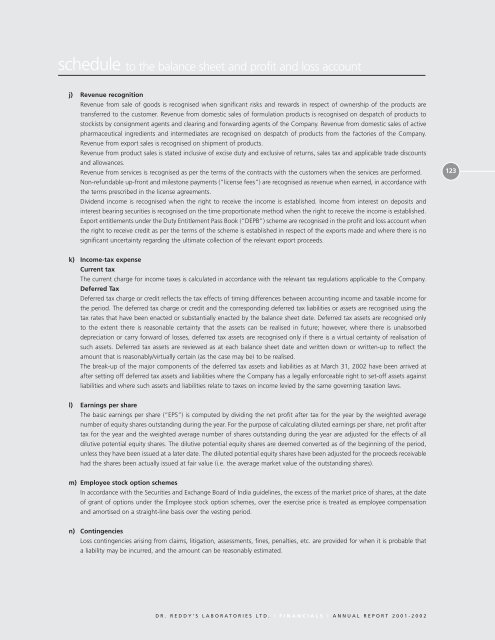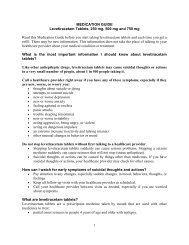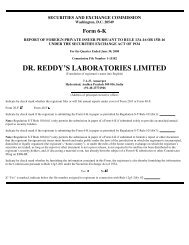DRIVIN G ROWTH - Dr. Reddy's
DRIVIN G ROWTH - Dr. Reddy's
DRIVIN G ROWTH - Dr. Reddy's
You also want an ePaper? Increase the reach of your titles
YUMPU automatically turns print PDFs into web optimized ePapers that Google loves.
schedule to the balance sheet and profit and loss account<br />
j) Revenue recognition<br />
Revenue from sale of goods is recognised when significant risks and rewards in respect of ownership of the products are<br />
transferred to the customer. Revenue from domestic sales of formulation products is recognised on despatch of products to<br />
stockists by consignment agents and clearing and forwarding agents of the Company. Revenue from domestic sales of active<br />
pharmaceutical ingredients and intermediates are recognised on despatch of products from the factories of the Company.<br />
Revenue from export sales is recognised on shipment of products.<br />
Revenue from product sales is stated inclusive of excise duty and exclusive of returns, sales tax and applicable trade discounts<br />
and allowances.<br />
Revenue from services is recognised as per the terms of the contracts with the customers when the services are performed.<br />
Non-refundable up-front and milestone payments (“license fees”) are recognised as revenue when earned, in accordance with<br />
the terms prescribed in the license agreements.<br />
Dividend income is recognised when the right to receive the income is established. Income from interest on deposits and<br />
interest bearing securities is recognised on the time proportionate method when the right to receive the income is established.<br />
Export entitlements under the Duty Entitlement Pass Book (“DEPB”) scheme are recognised in the profit and loss account when<br />
the right to receive credit as per the terms of the scheme is established in respect of the exports made and where there is no<br />
significant uncertainty regarding the ultimate collection of the relevant export proceeds.<br />
k) Income-tax expense<br />
Current tax<br />
The current charge for income taxes is calculated in accordance with the relevant tax regulations applicable to the Company.<br />
Deferred Tax<br />
Deferred tax charge or credit reflects the tax effects of timing differences between accounting income and taxable income for<br />
the period. The deferred tax charge or credit and the corresponding deferred tax liabilities or assets are recognised using the<br />
tax rates that have been enacted or substantially enacted by the balance sheet date. Deferred tax assets are recognised only<br />
to the extent there is reasonable certainty that the assets can be realised in future; however, where there is unabsorbed<br />
depreciation or carry forward of losses, deferred tax assets are recognised only if there is a virtual certainty of realisation of<br />
such assets. Deferred tax assets are reviewed as at each balance sheet date and written down or written-up to reflect the<br />
amount that is reasonably/virtually certain (as the case may be) to be realised.<br />
The break-up of the major components of the deferred tax assets and liabilities as at March 31, 2002 have been arrived at<br />
after setting off deferred tax assets and liabilities where the Company has a legally enforceable right to set-off assets against<br />
liabilities and where such assets and liabilities relate to taxes on income levied by the same governing taxation laws.<br />
l) Earnings per share<br />
The basic earnings per share (“EPS”) is computed by dividing the net profit after tax for the year by the weighted average<br />
number of equity shares outstanding during the year. For the purpose of calculating diluted earnings per share, net profit after<br />
tax for the year and the weighted average number of shares outstanding during the year are adjusted for the effects of all<br />
dilutive potential equity shares. The dilutive potential equity shares are deemed converted as of the beginning of the period,<br />
unless they have been issued at a later date. The diluted potential equity shares have been adjusted for the proceeds receivable<br />
had the shares been actually issued at fair value (i.e. the average market value of the outstanding shares).<br />
m) Employee stock option schemes<br />
In accordance with the Securities and Exchange Board of India guidelines, the excess of the market price of shares, at the date<br />
of grant of options under the Employee stock option schemes, over the exercise price is treated as employee compensation<br />
and amortised on a straight-line basis over the vesting period.<br />
n) Contingencies<br />
Loss contingencies arising from claims, litigation, assessments, fines, penalties, etc. are provided for when it is probable that<br />
a liability may be incurred, and the amount can be reasonably estimated.<br />
DR. REDDY’S LABORATORIES LTD. | FINANCIALS | ANNUAL REPORT 2001-2002<br />
123




